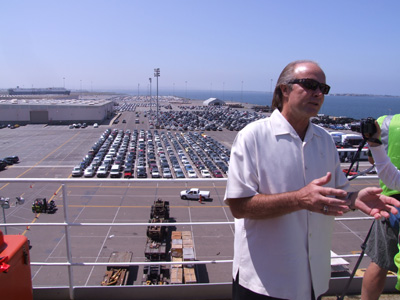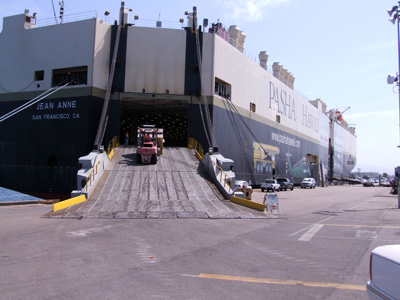
By Donald H. Harrison

NATIONAL CITY, California – Observing the National City Marine Terminal from the top deck of M.V. Jean Anne, a 13,000-metric ton ship that transports automobiles and other cargo between San Diego County and the Hawaiian Islands, I could imagine four 19th Century San Diego pioneers standing there with me and nudging each other with excitement over what lay spread out on the asphalt below.
Thousands of automobiles—which entrepreneurs and land developers Louis Rose, Alonzo Horton and the brothers Frank and Warren Kimball might have called “horseless carriages”—were lined up in rows on the 125-acre facility. Those cars facing south had just been taken off the 580-foot Jean Anne on that Thursday, May 13, and were bound either for large automobile-carrying trucks or for a special car-carrying train of the Burlington Northern Santa Fe Railroad, which would convey them to the American Southwest. Those cars facing north were about to be loaded onto the Jean Anne for shipment to Hawaii.
“Well, you boys got the railroad business,” I could imagine Rose and Horton telling the Kimball Brothers, owners of the National Ranch property that subsequently was developed into modern-day National City. “We’ll just have to hope some benefits will come to our areas too.”
While the Kimball Brothers were promoting National City as the ideal terminus for a railroad, Horton had been pushing the area that became today’s downtown San Diego. Rose, meanwhile, had been campaigning for his township of Roseville, which today is part of modern Point Loma.
While the three areas on the northern, central and southern portions of San Diego Bay had rivaled for the economic benefits that a railroad terminus might bring, their respective advocates knew that if San Diego Bay became the chief port in Southern California to handle both rail cargo and ship cargo, it’s future as a West Coast trading center would be secure – and all of them would benefit. So they cooperated in an effort to have a railroad select San Diego as its West Coast destination, while rivaling over just where in San Diego the actual terminus should be located.
Known for his optimism about San Diego County’s future–“Just wait awhile and you will see” was his motto–Rose might have kvelled along with his friends and rivals over the National City Marine Terminal. To their 19th-century eyes, all that activity with those new-fangled “cars” might have seemed a miracle, but in reality, as impressive as it is, it falls far short of their dreams. The Burlington Northern Santa Fe carries the automobiles to the greater Los Angeles area, from whence the automobiles are transferred to other trains on a variety of routes, some going east and some going north.
As the Kimball Brothers, Rose and Horton had envisioned the San Diego region’s future, trains from this area would have gone on a direct route to the East Coast across the southern tier states. In their dreams, San Diego would have become the gateway to the U.S. East Coast for Asian and Latin American goods, while for U.S. goods, San Diego would become the access point to all the foreign ports on the Pacific Ocean.
Such was not to be, for reasons both of politics and geography. The powerful Northern California-based owners of the Central Pacific and Southern Pacific Railroads did not want to see San Francisco challenged by San Diego as a prime port on the Pacific Coast and exercised considerable political clout in Washington D.C. to prevent that from happening.
Geography aided the cause of those “Big Four” railroad moguls Leland Stanford, Collis Huntington, Mark Hopkins and Charles Crocker, while dealing a major blow to the San Diegans. The steep and difficult terrain east of San Diego such as the Carrizo Gorge and the chasm at Pine Valley persuaded the 19th century engineers it would be easier to run a transcontinental railroad to the Los Angeles area and build a port at San Pedro than to attempt to engineer a transcontinental railroad directly to and from San Diego.
Today, the twin ports of San Pedro and Long Beach do a thriving container business, able to transfer cargo containers from ships to railroads and vice versa. In contrast, there are very few cargo containers in San Diego. Dirk Mathiasen, the vice president for operations of the Unified Port of San Diego, says rather than compete for that business, San Diego markets itself as a “non-containerized niche port.” “We are doing specialized cargo, very few containers, and we have skills and talents down here that you won’t find at a container port such as ro-ro (roll on, roll off) capabilities…”
The Jean Anne is such a roll-on, roll-off ship, capable of carrying as many as 4,000 automobiles at a time, but more often configured in such a way as to carry 2,500 vehicles and a variety of other kinds of non-containerized cargo, ranging from carnival rides to 100-ton transformers. Michael Caswell, Pasha’s Senior Vice President of Operations, says the ship with 400,000 square feet of deck space, also has carried modular homes, office buildings, 100-foot yachts and “just about anything we can lift up to 120 tons.”

A visit to the Jean Anne is like a visit to a 10-story parking garage, only this one floats. The top three decks of the ship can be raised or lowered like shelves in a cabinet in order to better accommodate variable loads.
Cars and cargo are loaded onto Jean Anne in reverse order of the ports on which the ship will call in Hawaii – that is, cars bound for the port Jean Anne will visit first are loaded onto the ship last, so that they can be off-loaded without having to move any of the other cargo around.
Automobiles therefore are clustered in groups at the National City Marine Terminal to they can be placed on the ship in logical order.
From the deck of Jean Anne on May 13, one could see at the far southern end of the pier another ship, a Hoegh Autoliner, which had unloaded Hondas for transport on the Burlington Northern Santa Fe. That railroad company recently spent $25 million to upgrade its facilities at the National City Marine Terminal, according to Mathiasen.
Besides handling its own ship’s operations, Pasha with a $20 million yearly payroll in National City serves as an agent for Honda and almost every other foreign automobile manufacturer in the world that offloads its cars at San Diego. In the current year, approximately 250,000 vehicles are passing through the terminal, but more than 400,000 have passed through here in better economic times. If there is an economic surge, that number could grow to 500,000.
Besides moving the cars from one conveyance to another, Pasha also performs a variety of “value-added” tasks for the car manufacturers. For example , workers may install radios on the cars, or make certain that up-to-date owner manuals are placed in the glove compartments.
*
Harrison is editor of San Diego Jewish World.